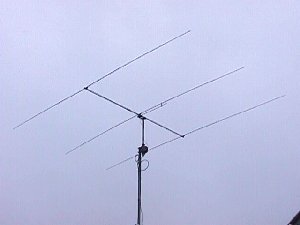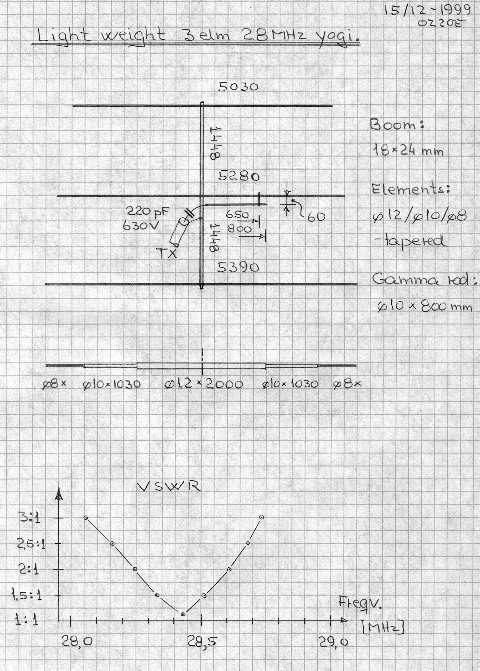Homebuilding of a low cost 28 MHz yagi using parts from ordinary TV antennas.

Background:
In the solar maximum years 28 MHz is full of DX stations, that can be worked with very simple equipment. However the fun will be even greater with a proper antenna. So I decided to build a 3 elm. yagi and took the design from ARRL's: "Yagi Antenna Design" by W2PV. But I also wanted to see, if it was possible to build it from the materials normally used for VHF (TV) antennas.One reason was to have a real low cost design, where a couple of old Band l TV antennas would supply all the building material, another reason is that working for a TV-antenna producing company, I have easy access to building materials from the production left-overs.
The design:
The boom is made from square 18x24 mm aluminum. The elements from tapered aluminum tubing of 12mm, 10mm and 8mm diameter. The ø12mm center section is 2000mm long, two pieces of 1030mm ø10mm is inserted 30mm into the ø12mm piece and locked with a self tapping screw. This gives a very light 4 meter long element. Two pieces of ø8mm tubing are added to reach the final length of each element. The elements are mounted on top of the boom using metal brackets.The gamma match is made from 800mm ø10 tubing mounted 60mm under the driven element. The series capacitor was found experimentally; remember to use a high voltage low loss type at this place! Because of the thin elements the resonance length must be recalculated, so I spend some time with my pocket calculator and ARRL's: "Yagi Antenna Design", and came up with the following measures:

Results:
By adjusting the length of the Gamma match and the series capacitor, the VSWR can be adjusted to 1.1:1 at 28.4 MHz - the bandwidth is a bit narrow due to the thin elements, but for my TS820 that's no problem.On the air there was an immidiate difference of almost 2 S-units between the beam and my old 5/8 wavelength vertical. Instead of always having to call others, I could now call CQ - and get answers. And within two days of putting the beam up I worked VK9NS.
Mechanical strength:
This antenna is made from light materials. It will not be able to withstand a severe hurricane - the kind that hits me every 3 to 5 years. But being low cost and home build! I have simply prepared myself by stocking some alu tubes for new elements. If and when the antenna is damaged I can repair in an hour.Until now it has survived storms having 20 m/s (72 km/h) average windspeed with 30 m/s (108 km/h) gusts. When expecting a storm it's wise to turn the antenna so the windload on the elements is as low as possible.
Back to OZ2OE homepage.